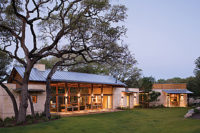The ranch includes four buildings, including three structures that make extensive use of natural stone — the main house, guest house and barn.
“The family wanted to move from a more urban setting to a real ranch, and they had this acreage in a very rural setting called Paradise,” Chambers explained. “Part of the initial project was to try do some actual land planning to locate all of the buildings. What was important to them was to preserve as much of the natural beauty of the site as possible — the trees, the natural vegetation; the habitat for the animals that lived there. They also wanted to take advantage of the views. The property is somewhat rolling, and had some topography and trees. We wanted to lay out the buildings to take advantage of the views and topography, while also keeping it private.”
Another important goal for the project was to reflect the traditional architecture of Texas. “Both of the owners are fifth-generation Texas natives, so the Texas look was important to them, and especially the Hill Country look,” Chambers said, referring to a region in Central Texas where limestone houses and barns reflect a sense of permanence. “She is originally from the Hill Country, and she wanted it to resemble something that was authentic from the Fredericksburg area of Texas.”
The project also needed to serve a practical purpose. “It is an active ranch; not a weekend pleasure ranch,” Chambers said. The main business of this ranch and all of its structures is dressage, an equestrian sport defined by the International Equestrian Federation as “the highest expression of horse training.”
Reflecting Texas tradition
All of the structures, including the larger ranch home, retain the straightforward, authentic details of historic Texas ranches. “I spent some time studying the historic examples of early Texas ranch architecture and also early Texas stonework. It is one thing to design a building that has the shape of an old historic house, but you also need to make the stonework look historic. We used veneer pieces, and we spent some time studying the historical look to make it appear as solid masonry.”
The first structure to be completed was the guest house, which was designed in the characteristic style of the “Sunday Houses” of mid-19th century Texas. These Sunday Houses were used by farmers and ranchers as small places to stay while shopping on Saturdays and church-going on Sundays. In addition to limestone, traditional design elements include galvanized metal roofing, exposed rafter tails, cedar posts and subtle arches above windows.
“Because they lived near Dallas, the owners wanted a place to stay on the property while the ranch and the barn were being built,” Chambers said. “They would go up there and spend a few days, and they really fell in love with the little house before we finished the main house.
Both the Sunday House and the main ranch structure feature the same limestone, which came from a quarry site in Jarrell, TX. “The owners wanted something that resembled the stone from the Hill Country, and the simplest way to do it was to select stone that actually came from a quarry in Central Texas,” the architect explained. “The stone actually is cut into slabs, and the vertical cuts were made on the job. It has a chopped face that almost gives it the look of a chamfered edge look. It is not a modular stone at all; it is pretty random and 4 to 5 inches thick. We used the same thickness of stone inside as well. Sometimes the stone wraps around a corner, and we made it look like a solid masonry wall.”
Stone details
Among the details, various stone treatments were used at the windows, doors and other openings. “We have some real arches that were just built the old fashioned way, and we also have some cut stone lintels,” Chambers said. “These lintels are 5-inch-thick x 12-inch-tall pieces of cut limestone, and the lengths were cut on the job.”
Some practical consideration went into the engineering of the lintels. “Limestone is relatively soft, and any kind of stone doesn’t work in tension,” the architect explained. “We used steel lintels, and we put them above the stone lintels, so the steel supports all of the stone walls above the lintels, and the [stone] lintel just supports itself.”
The residential spaces also feature multiple Rumford fireplaces, which also utilize limestone. “Almost all of our fireplaces use a Rumford design,” Chambers said. “It is a fireplace that was designed in the 1790s by Count Rumford, and the technology was lost, but it has been revived. Fireplaces are inherently inefficient, but the Rumford one is most efficient in terms of putting heat in the room.”
In yet another use of stone, the barn is from DC Morgan Concrete & Barns of Chillicoth, OH, and it features the same limestone as the residential structures. “The owners chose to use them, and I looked at the drawings and gave them some advice on how we could make it look better,” he said. “The Morgan buildings are efficient and economical, but they are plain. We raised the center aisle of the barn and the pitch a little bit. We also added some wood trim and ledges where we could put stone, and when it was all done, Morgan was proud of the job. For an inexpensive barn, it came out great. The stone added a lot of rustic character to the barn. It has a metal exterior. It isn’t done with siding. We added the stone and wood trim and it softened it up a bit; it makes it look a little more historical.”
The mason on the project was Mike Evans of Weatherford, TX. “He was really knowledgeable, and he did a great job,” Chambers said. “He’s an actual craftsman; not just a stone layer. We had an incredible general contractor, and they did a really good job of following our specifications.”
Overall, the installation process went smoothly. “Working with the site was the largest challenge,” Chambers said. “The Post Oak trees were very sensitive to any kind of disturbance or any change in their environment. The issue was trying to locate the buildings while making sure that we didn’t change the grade around the trees, so we built retaining walls.”
Since its completion, the project has received several accolades. The Sunday House received the Home of the Year Award from Southern Living Magazine, and it was also included in the book “Roots of Home” by Russell Versaci, AIA, who referred to it as “Very pure in design and appearance — the architectural detailing and materials are appropriate for the Texas Hill Country.”












